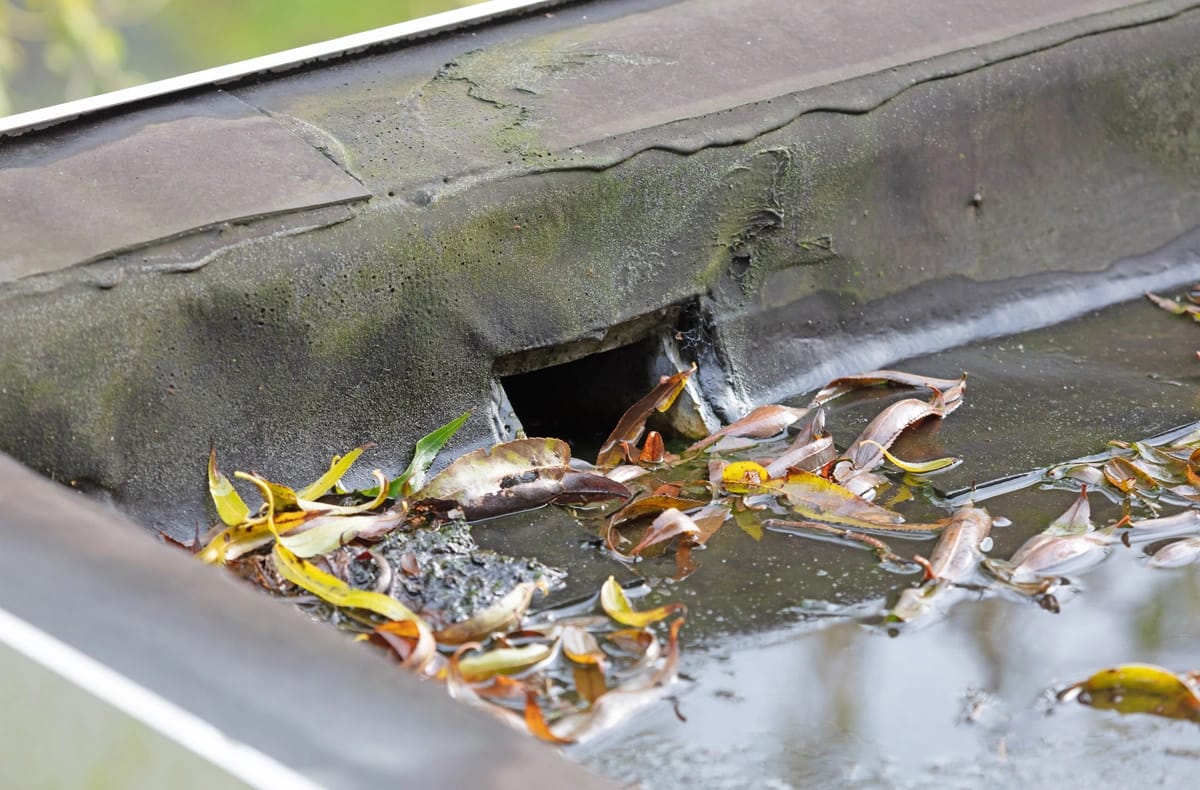Flat roofs are a common feature in modern architecture, offering sleek designs and efficient use of space. However, they come with their own set of challenges, one of the most significant being leaks.
A leaky flat roof can lead to a myriad of issues, from water damage to mold growth, causing headaches for homeowners and business owners alike. Today, we’ll help you tackle flat roof leak repair head on, breaking down everything you need to know, including:
- Understanding the causes of leaks
- Prevention strategies
- The importance of hiring a professional
Understanding Flat Roof Leaks
Flat roofs are particularly susceptible to leaks due to their design and materials used. Common causes of flat roof leaks include:
- Poor Installation: Improper installation can lead to weak spots and gaps in the roofing membrane, allowing water to seep through.
- Age and Wear: Over time, flat roofs deteriorate due to exposure to the elements, leading to cracks, tears, and deterioration of sealants.
- Ponding Water: Flat roofs often have inadequate drainage, leading to water pooling or ponding, which can weaken the roof membrane and cause leaks.
- Extreme Weather: Harsh weather conditions such as heavy rain, snow, and high winds can exacerbate existing roof issues and lead to leaks.
- Damage: Accidental damage from foot traffic, falling debris, or equipment can puncture the roof membrane, allowing water to infiltrate.
Signs of Flat Roof Leaks
Detecting a flat roof leak early is crucial to prevent extensive damage. Look out for the following signs:
- Water Stains: Stains on the ceiling or walls indicate water infiltration from the roof.
- Dripping Water: The presence of dripping water inside the building, especially during or after rainfall, signals an active leak.
- Mold and Mildew: Moisture from a leaky roof creates ideal conditions for mold and mildew growth, which can cause health hazards.
- Blisters or Bubbling: Blisters or bubbles on the roof surface indicate trapped moisture, which can lead to leaks if left unaddressed.
- Peeling Paint or Wallpaper: Moisture infiltration can cause paint or wallpaper to peel away from the walls or ceiling.
How to Find Where a Flat Roof Leak is Coming From
Finding the source of a flat roof leak can sometimes be challenging, as water can travel along various paths before becoming noticeable. Here are some methods to help you pinpoint the origin of the leak:
Visual Inspection
Begin with a thorough visual inspection of the roof’s surface and interior. Look for obvious signs of damage, such as cracks, blisters, or punctures in the roofing material. Inside, examine the ceiling and walls for water stains or bubbling paint which can indicate the general area where the water is entering.
Check Roof Penetrations
Inspect areas where the roof is penetrated by elements such as vents, chimneys, and skylights. These are common sources of leaks due to gaps or failures in the sealing materials. Ensure that all flashes, seals, and gaskets are intact and free from wear.
Use of Water Hose
Enlist an assistant and use a garden hose to simulate rainfall. Start by spraying water on the suspected area for a few minutes while your assistant monitors the interior space for leaks. Gradually move the hose to different sections of the roof, working systematically until water intrusion is observed, pinpointing the exact source.
Infrared Scanning
Consider using infrared scanning to detect moisture trapped within the roof’s layers. Professional roofers often employ this technology, as it can reveal hidden leaks that are not visible to the naked eye. The infrared camera picks up temperature variations, highlighting moist areas that need attention.
Check Roof Drainage
Ensure the drainage system is functioning correctly. Blockages or pooling water can contribute to leaks. Examine gutters, downspouts, and drainage channels for clogs or damage, and perform necessary cleaning or repairs to keep water flowing off the roof efficiently.
How to Repair a Flat Roof Leak in 6 Steps
Ready to repair a flat roof leak like a pro? These are the steps you should take for guaranteed success.
1. Identify the Source of the Leak
The first step to fixing a flat roof leak is to locate where the water is entering. Look for visible signs such as water stains on the ceiling, puddles, or damaged roofing material. Sometimes, the leak may be several feet away from where it appears, so be thorough in your inspection.
2. Clean the Area
Once you’ve found the leak, clean the surrounding area thoroughly. Remove any debris, dirt, or loose material using a brush or broom. This ensures that the repair materials will adhere properly to the roof surface.
3. Dry the Affected Area
Before you start the repair, make sure the leak area is completely dry. Use a cloth to soak up any standing water and allow the area to air dry if possible. Working on a dry surface ensures better adhesion of the patching materials.
4. Apply Roofing Cement
Using a putty knife, apply a generous layer of roofing cement over the leak. Spread it evenly to cover the damaged area, ensuring there are no gaps or thin spots. Roofing cement creates a waterproof barrier that seals the leak effectively.
5. Add a Patch
Cut a piece of roofing fabric or patching material slightly larger than the repaired area. Press it firmly into the wet roofing cement to ensure it adheres well. Once positioned, apply another layer of roofing cement over the patch, making sure to cover the edges thoroughly. This helps secure the patch and prevents future leaks.
6. Inspect and Maintain
After the repair has dried, inspect the area to ensure the leak is sealed. Check for any missed spots or weak points that may need additional attention. Regular maintenance of your flat roof, including periodic inspections and cleaning, can prevent future leaks and prolong the roof’s lifespan.
Following these six steps will help you effectively repair a flat roof leak, keeping your home dry and protected. If the damage is extensive or you’re unsure about the repair process, consider consulting a professional roofer for assistance.
Why You Should Work with a Commercial Roofing Professional
While DIY flat roof repairs may seem tempting, working with a professional roofing contractor offers several advantages:
- Expertise and Experience: Professional roofers have the knowledge and experience to accurately diagnose roof issues and provide effective solutions.
- Quality Workmanship: Roofing professionals use high-quality materials and techniques to ensure long-lasting repairs and prevent future leaks.
- Safety: Roof repairs can be dangerous, especially on flat roofs. Professional roofers are trained in safety protocols and have the necessary equipment to work safely at heights.
- Warranty Protection: Many roofing contractors offer warranties on their workmanship, providing peace of mind and protection against future issues.
- Cost-Effective Solutions: While hiring a professional may seem more expensive upfront, it can save you money in the long run by preventing further damage and costly repairs.
Preventing Leaks in Flat Roofs
Prevention is key to avoiding flat roof leaks. Here are some preventive measures you can take:
🗓️ Regular Inspections:
Schedule regular inspections by a professional roofing contractor to detect and address potential issues before they escalate.
💧 Proper Drainage:
Ensure that flat roofs have adequate drainage systems in place to prevent water from pooling or ponding.
✂️ Trim Overhanging Branches:
Trim trees near the roof to prevent branches from damaging the roof membrane or blocking drainage.
🍁 Maintain Gutters and Downspouts:
Keep gutters and downspouts clean and free of debris to ensure proper water flow off the roof.
⏰ Address Minor Issues Promptly:
Don’t ignore minor roof problems such as loose seams or small cracks. Address them promptly to prevent them from becoming major leaks.
How Long Repairs Take
The duration of flat roof leak repairs depends on various factors, including the extent of damage, weather conditions, and the availability of materials. Minor repairs such as patching small leaks can typically be completed within a day, while more extensive repairs or roof replacement may take several days or weeks to complete. Your roofing contractor can provide a timeline based on the specific requirements of your project.
Your Go-To Contractor for Flat Roof Repair
Flat roof leaks are a common problem that can cause significant damage if left unaddressed. By understanding the causes of leaks, recognizing the signs of a leaky roof, and taking proactive measures to prevent leaks, you can protect your property and ensure the longevity of your flat roof.
When it comes to repairs, entrusting the job to a professional roofing contractor is the safest and most effective approach, offering quality workmanship and peace of mind. Remember, a stitch in time saves nine when it comes to flat roof leak repair. Contact your trusted roofing contractors at G. Cannon Roofing for expert care for your roofing material today! We service Norristown, King of Prussia, Blue Bell, and surrounding Pennsylvania cities.








